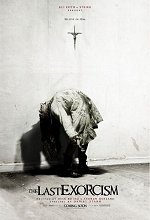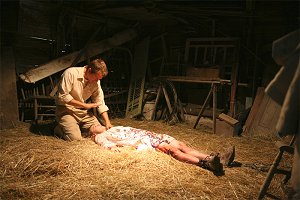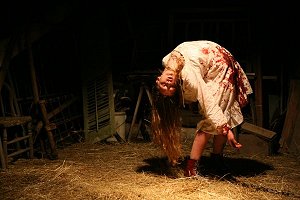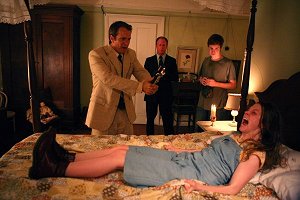 |
|
At The Picture Show
|
August 2010
Does camcorder footage come with a built-in orchestral score?
Artificial elements disrupt the supposed 'realism' of faux-doc 'The Last Exorcism'

The Last Exorcism
Lionsgate
Director: Daniel Stamm
Screenplay: Huck Botko and Andrew Gurland
Starring: Patrick Fabian, Ashley Bell, Louis Herthum, Iris Bahr, Caleb Landry Jones and Tony
Bentley
Rated PG-13 / 1 hour, 27 minutes


 (out of four)
(out of four)
As the first-person documentary style of filmmaking has become a recurring trend, I've often
found myself complaining about it. Not necessarily the technique itself, with which I have no
problem, but with the arbitrary or even pointless way it gets used. I made this complaint when
reviewing the popular Spanish horror flick [REC] last year, and its 2010 sequel had the same
problem.
This is not to say that the style hasn't had its high points - 1999's ahead-of-its-time The Blair
Witch Project and Matt Reeves' Cloverfield come to mind. But it seems too many people have
latched on to the technique without knowing what to do with it, or what its purpose is.
 Here we have another example, The Last Exorcism, which
at least has some motivation and purpose behind its stylistic choice, and yet still manages to
screw it up. The idea is that we're seeing an attempted documentary about a famed evangelical
preacher named Cotton Marcus (Patrick Fabian), who once specialized in performing exorcisms,
and now wants to expose the entire idea of exorcism as an outright hoax.
Here we have another example, The Last Exorcism, which
at least has some motivation and purpose behind its stylistic choice, and yet still manages to
screw it up. The idea is that we're seeing an attempted documentary about a famed evangelical
preacher named Cotton Marcus (Patrick Fabian), who once specialized in performing exorcisms,
and now wants to expose the entire idea of exorcism as an outright hoax.
A camera crew follows Mr. Marcus around, splicing in footage of his Sunday sermons, as he
explains his con artistry in detail. The key to exposing the fraud is to take one last "possession"
case, capture it all on camera and prove to the world that his exploits were really just an
elaborate magic trick all along.
The film's early events proceed in pure documentary style - deliberately presented in unpolished
form that suggest this all may be "found" footage - and yet the filmmakers abandon that stylistic
integrity halfway through. When things finally start to hit the fan, suddenly everything is
accompanied by ominous music - the kind of run-of-the-mill music that would normally
accompany your typical suspense/horror movie. Yet in The Last Exorcism, it's a complete
anachronism - an element so out of place it completely undermines the supposed realism that
director Daniel Stamm had so patiently established.
 Why the sudden artificial element, injected into an
environment in which it has no place? I don't know, and I'll never understand it as an artistic
choice. To venture a guess, I wouldn't be surprised if it was the result of studio meddling or
test-screening - maybe the scenes in question didn't play "scary" enough, so a score was added
to artificially increase the tension for those who need such an external suggestion. (Or maybe
the scenes really weren't effective without the music - to which I respond, they aren't effective
with the music, either.)
Why the sudden artificial element, injected into an
environment in which it has no place? I don't know, and I'll never understand it as an artistic
choice. To venture a guess, I wouldn't be surprised if it was the result of studio meddling or
test-screening - maybe the scenes in question didn't play "scary" enough, so a score was added
to artificially increase the tension for those who need such an external suggestion. (Or maybe
the scenes really weren't effective without the music - to which I respond, they aren't effective
with the music, either.)
But like I said, that's just a guess. Whatever the case, it's an unfortunate disruption for what
should have been the film's most chaotic and unrefined scenes - in other words, the scenes that
could have benefitted most from the absence of any filmmaking element as polished and
deliberate as a musical score.
What are we to think, then, of the entire faux-doc technique the movie employs? If it's nothing
more than an arbitrary device, and the film can immediately revert into your standard horror flick
whenever it wants, what's the point in the first place? If you're going to go in a particular artistic
direction, at least have the courage to stick with it.
 The Last Exorcism isn't a badly made film. In fact, it's one
of the better entries into the exorcism subgenre, in part because of its narrative device. Fabian
makes for a reasonably convincing preacher/charlatan, and the revelations of the film's third act
present some surprising and troubling ideas. But it also suffers from an uneven tone and fails to
create the type of unsettling atmosphere it's aiming for - two issues that only become more
problematic once the score starts to inexplicably inject itself into the action.
The Last Exorcism isn't a badly made film. In fact, it's one
of the better entries into the exorcism subgenre, in part because of its narrative device. Fabian
makes for a reasonably convincing preacher/charlatan, and the revelations of the film's third act
present some surprising and troubling ideas. But it also suffers from an uneven tone and fails to
create the type of unsettling atmosphere it's aiming for - two issues that only become more
problematic once the score starts to inexplicably inject itself into the action.
If the filmmakers had had the conviction to follow through on their own premise, rather than
resorting to measures that inform and force our emotional reactions, they may have had
something worthwhile. Instead, they've succeeded only in exposing the hang-ups of this brand of
filmmaking.
Continued Below Advertisement
Read more by Chris Bellamy